- Last Date to Submit IGNOU Project / Dissertation /Practical Files/ Internship Report for TEE June 2025 is 31st May 2025 as of now.
- Students are supposed to submit their Project/Dissertation/Practicum Files/Internship Report through online mode only.
- Reports sent through any form other than official link put by University will be taken as invalid.
- In case of submission of Project report or dissertations, documents such as Proposal Proforma, Synopsis, bio data of project, originality certificate needs to be duly signed in original by student and project guide before submission.
- Make sure to scan all the page of the report properly using a Mobile Camscan or a Scanning machine. Here are more details about IGNOU project submission.
- The File needs to be of maximum size of 25MB in case of Project Report or Dissertation in PDF format only.
How To Submit Your IGNOU Project File ?
Below are the steps to submit your Project/ Dissertation /Practical Files/ Internship Report Submission through online mode.
1. Visit Online Submission Link:
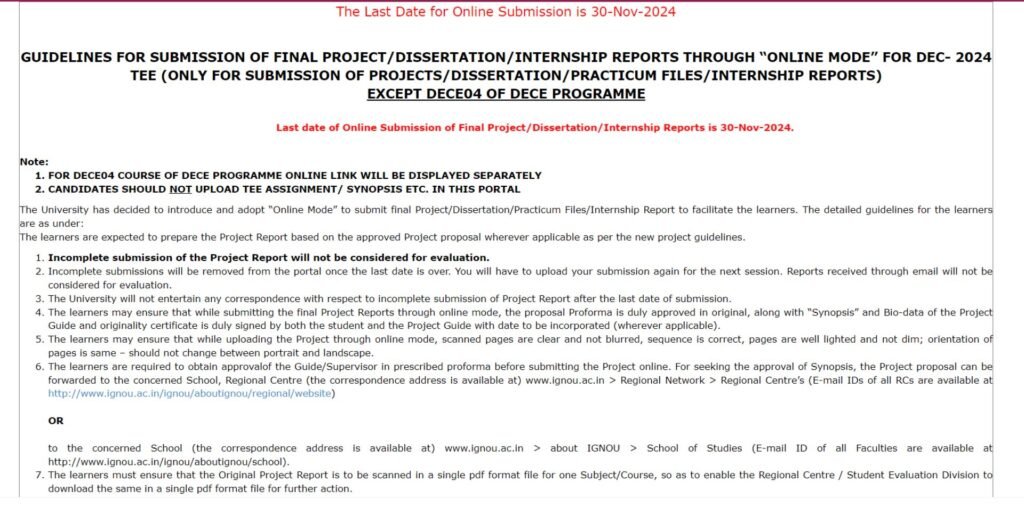
Visit https://onlineproject.ignou.ac.in/projectjun25/ set by University for TEE June 2024 for online submission of project files. Link for project submission for TEE December 2024 is yet to be released. Please note this is not assignment submission link and hence refrain from submitting assignments through this link.
2. Read Instructions to Continue:
Read the instructions mentioned and scroll at the bottom of page. Click ‘Yes’ to continue. Next, click on ‘Proceed to Upload Project / Dissertation / Internship Report’.
3. Enter Login Details:
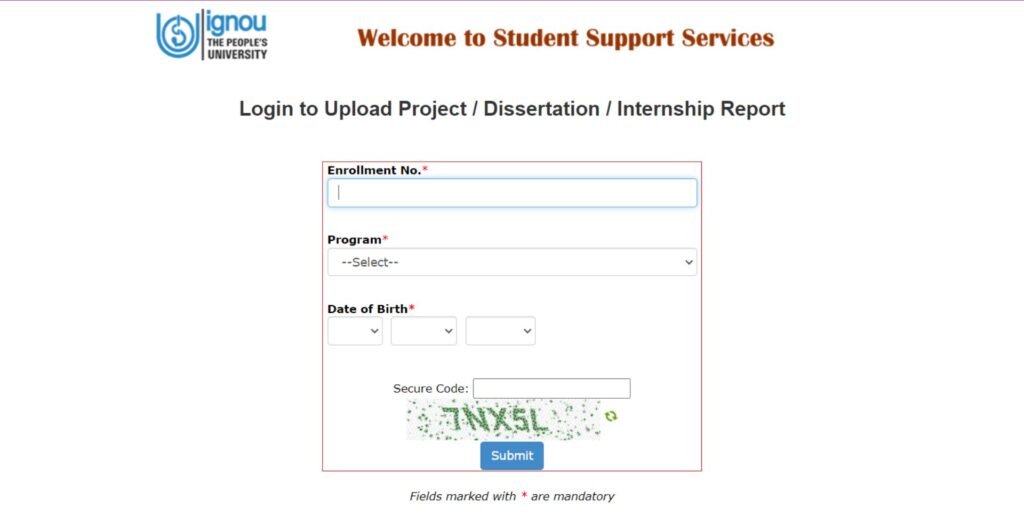
You will see a screen asking with login. Enter details such as Enrollment Number, Programme Code and Date of birth. Next, enter the captcha and then click ‘Submit’.
4. Enter Project Details and Upload Document
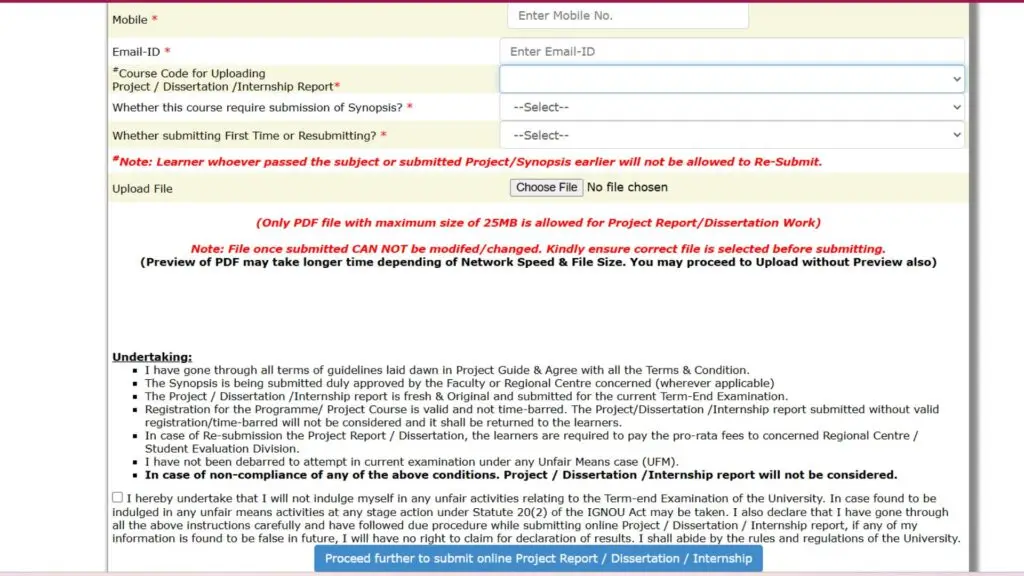
On the next page, you will see your student details auto filled, while you need to put down other details such as Mobile number, Email ID, Course Code for Uploading Project / Dissertation /Internship Report and synopsis details. Then, Upload the project report in the form of scanned PDF. Make sure to create single PDF file for 1 subject and upload the same.
IGNOU Project Report or Dissertation June 2025: How to Prepare

An IGNOU project report is a comprehensive document that showcases a student’s research, analysis, and findings on a particular topic within their field of study. Whether for a Bachelor’s, Master’s, or other program, IGNOU project reports are a vital component of academic assessment and evaluation. Here’s a structured outline of what an IGNOU project report typically includes:
1. Title Page/ First page :
- Title of the project
- Student’s name
- Enrollment number
- Program name and code
- Date of submission
- Name of the university (Indira Gandhi National Open University)
- Logo or seal of the university
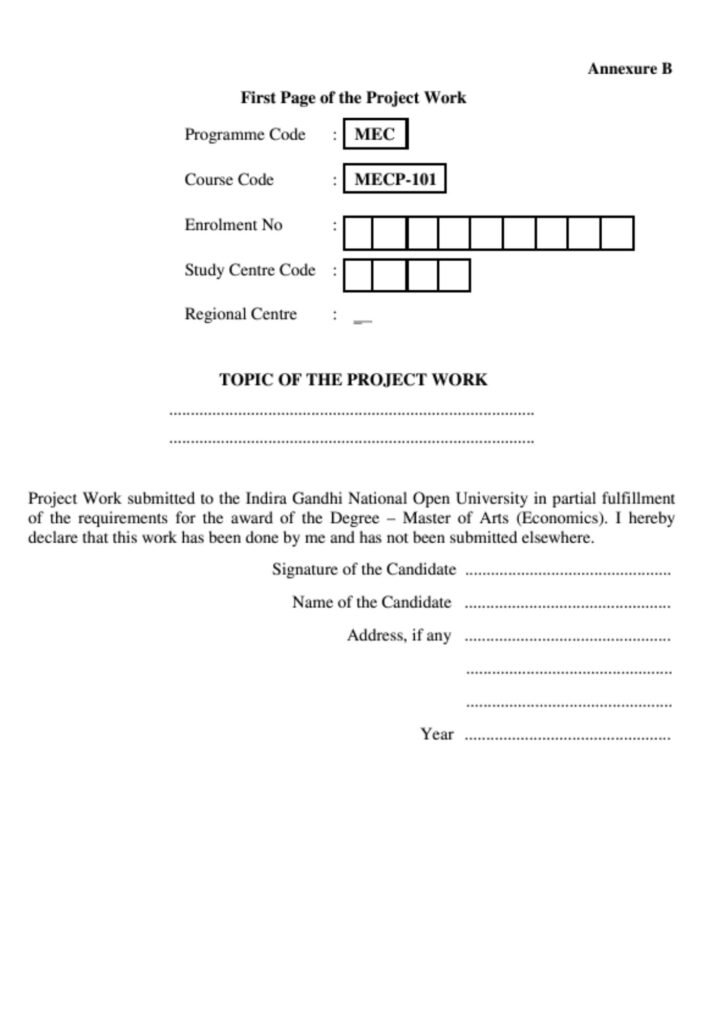
2. Declaration:
- A statement declaring that the project report is the original work of the student.
- Declaration of any sources of information used, duly acknowledged through citations and references.
- Signature of the student and date.
3. Certificate:
A certificate signed by the project supervisor or coordinator acknowledging the completion and submission of the project report.
4. Acknowledgments:
A section where the student expresses gratitude to individuals or organizations who provided support, guidance, or assistance during the course of the project.
5. Abstract:
A concise summary of the project report, including its objectives, methodology, key findings, and conclusions. Typically around 150-250 words.
6. Table of Contents:
A list of all major sections and subsections of the project report along with their respective page numbers for easy navigation.
7. List of Figures and Tables (if applicable):
A separate list enumerating all figures and tables included in the project report, along with their corresponding page numbers.
8. Introduction:
- Background information on the topic of the project.
- Statement of the problem or research question.
- Objectives or aims of the project.
- Significance or relevance of the study.
9. Literature Review:
- Review of existing scholarly literature relevant to the topic.
- Summary and synthesis of key findings from previous studies.
- Identification of gaps in the literature that the project aims to address.
10. Methodology:
- Description of the research approach and methods used in the project.
- Explanation of data collection methods (e.g., surveys, interviews, experiments).
- Justification for the chosen methodology and discussion of any limitations.
11. Results:
- Presentation of research findings in a clear and organized manner.
- Use of tables, charts, graphs, or other visual aids to illustrate key findings.
- Discussion of any patterns, trends, or relationships observed in the data.
12. Discussion:
- Interpretation of the results in relation to the research objectives.
- Comparison of findings with existing literature.
- Analysis of implications, limitations, and potential areas for future research.
13. Conclusion:
- Summary of the main findings and their implications.
- Restatement of the research objectives and how they were addressed.
- Recommendations for future research or practical applications.
14. References:
List of all sources cited in the project report, formatted according to the prescribed citation style (e.g., APA, MLA).
15. Appendices (if applicable):
Additional supplementary material such as survey questionnaires, interview transcripts, or raw data.
It’s essential to adhere to the formatting and citation guidelines provided by IGNOU for project reports, including font size, margins, line spacing, and citation style. Additionally, students should carefully proofread their project reports for grammar, spelling, and punctuation errors before submission. Some courses might also share Project report guidelines with templates and outline structure. Make sure to look for the same in your programme guide.
How to Get Project Proposal Proforma Approved?
A Proposal Proforma is a structured document that outlines the intended research study. IGNOU has an official template for the proforma depending upon the programme you are enrolled in. Usually, you can find the propsal proforma as part of your programme guide or project report guidelines created by your programme faculty. Usually, you are supposed to attach the synopsis and bio data of your project along with the proforma for approval. For approval, you need to send the copy of your propsal Proforma at RC or Concerned School. You can contact your Study Centre or Regional Centre to find out more information.
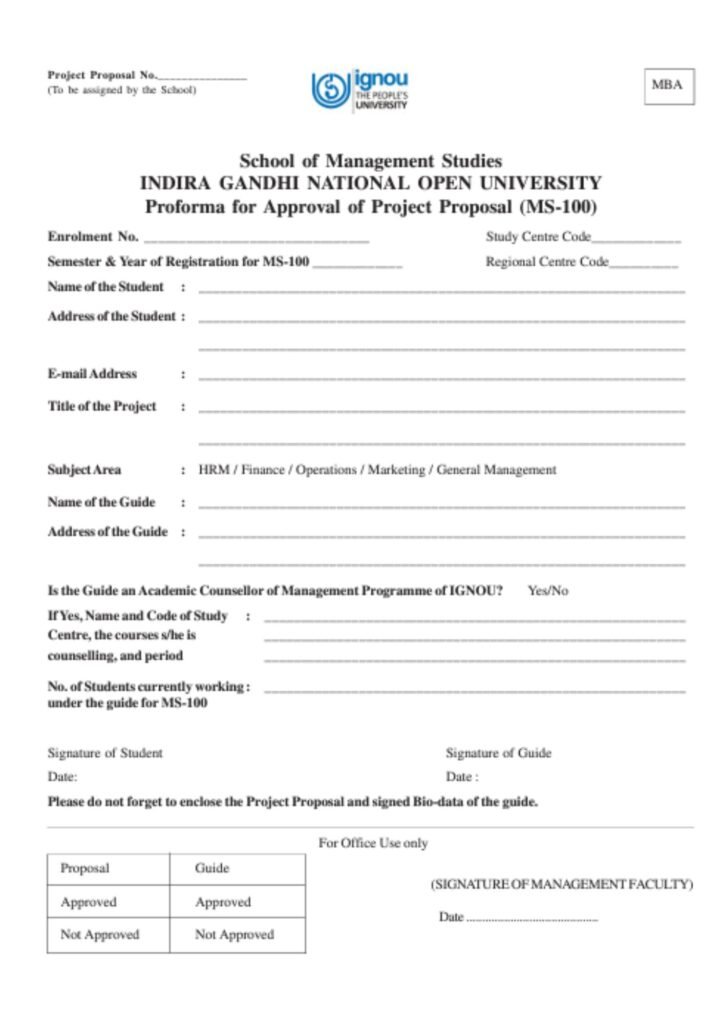
IGNOU Practical File or Practum Dec 2024: How to Prepare
Practical files are an integral part of many courses offered by the Indira Gandhi National Open University (IGNOU). These files serve as documentation of the practical work completed by students as part of their coursework. Here’s a breakdown of what IGNOU practical files typically include:
1. Cover Page:
The Cover Page of the IGNOU Practical File should consist of the below:
- Title of the practical file.
- Student’s name.
- Enrollment number.
- Program name and code.
- Course name and code.
- Date of submission.
- University name (Indira Gandhi National Open University).
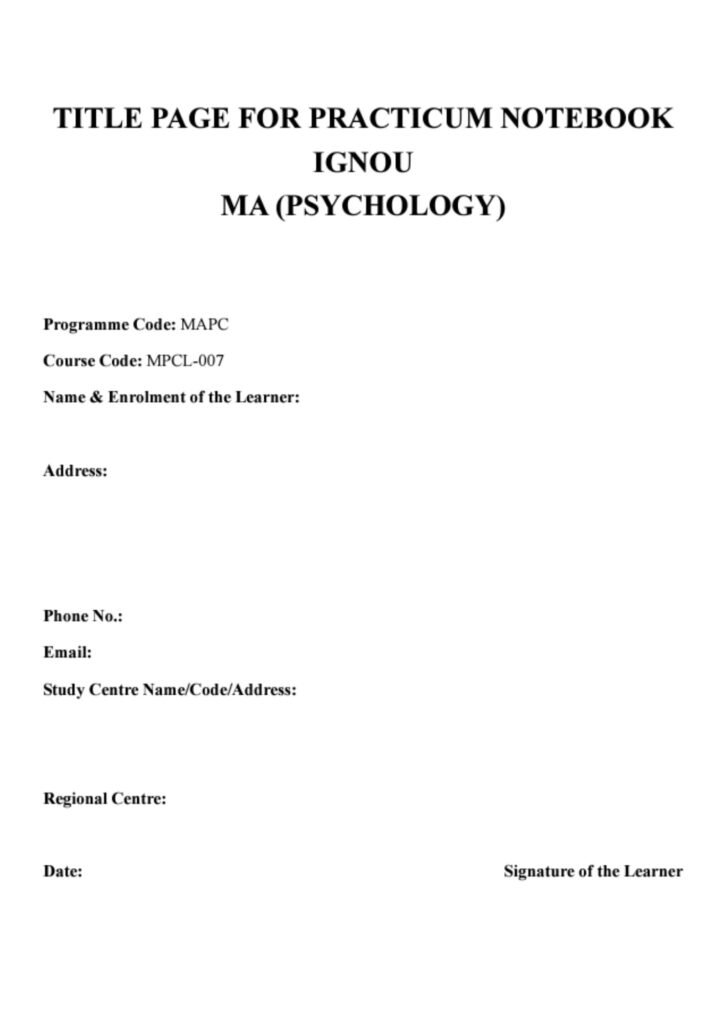
2. Table of Contents:
A list of all sections and subsections in the practical file along with their respective page numbers.
3. Introduction:
- Overview of the practical work to be documented.
- Explanation of the objectives and purpose of the practical activities.
4. Experiment Details:
- Detailed descriptions of each experiment or practical activity undertaken.
- Clear and step-by-step instructions for conducting the experiments.
- List of materials and equipment required for each experiment.
5. Observations and Results:
- Recorded observations and data collected during the practical activities.
- Presentation of results in tables, charts, graphs, or other visual formats.
- Analysis and interpretation of the results obtained.
6. Discussion:
- Interpretation of the results in the context of the objectives of the practical work.
- Comparison of observed outcomes with expected outcomes.
- Discussion of any challenges faced during the practical activities and how they were addressed.
7. Conclusion:
- Summary of the main findings and outcomes of the practical work.
- Reflection on the significance of the practical activities in relation to the course objectives.
- Recommendations for future improvements or modifications to the practical exercises.
8. References:
List of all sources consulted or referenced in the practical file, formatted according to the prescribed citation style (e.g., APA, MLA).
9. Appendices:
- Supplementary material such as raw data, calculations, diagrams, or additional documentation related to the practical activities.
- Any supporting documents provided by the course instructor or obtained during the practical work.
Note: It’s important for students to follow any specific instructions or guidelines provided by their course instructor or program coordinator regarding the format and content of practical files. Additionally, students should ensure that their practical files are well-organized, clearly written, and free of errors before submission.
IGNOU Internship Report : How to Prepare
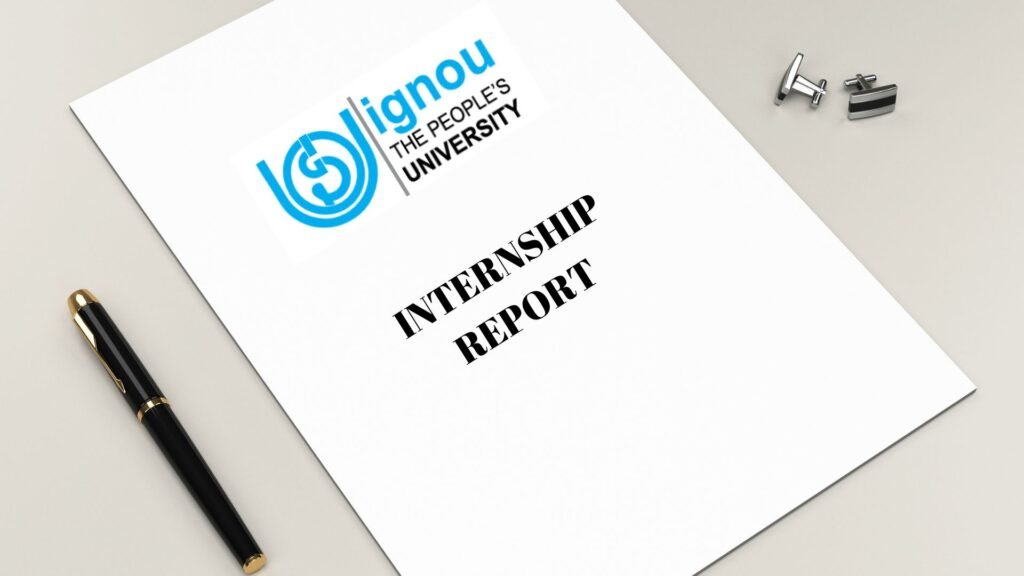
An internship report for the Indira Gandhi National Open University (IGNOU) typically documents a student’s experience, learning, and contributions during their internship period. Here’s a structured outline of what an IGNOU internship report usually includes:
1. Cover Page:
- Title of the internship report
- Student’s name.
- Enrollment number.
- Program name and code.
- Name of the organization where the internship was conducted.
- Date of submission.
2. Acknowledgments:
A section where the student expresses gratitude to individuals or organizations who provided support, guidance, or assistance during the internship.
3. Executive Summary:
- A brief overview of the internship experience, highlighting key activities, achievements, and learnings.
- Summary of the organization, its mission, and the internship objectives.
4. Introduction:
- Background information on the organization where the internship was conducted.
- Explanation of the purpose and objectives of the internship.
- Description of the student’s role and responsibilities during the internship period.
5. Organization Profile:
- Overview of the organization, including its history, mission, vision, and organizational structure.
- Description of the department or division where the internship took place.
- Brief profiles of key personnel or supervisors involved in the internship program.
6. Internship Activities:
- Detailed description of the tasks, projects, and activities undertaken during the internship.
- Explanation of how these activities contributed to the student’s learning and professional development.
- Use of specific examples and anecdotes to illustrate key experiences and challenges faced during the internship.
7. Learning Outcomes:
- Reflection on the knowledge, skills, and competencies gained through the internship experience.
- Analysis of how the internship contributed to the student’s academic and career goals.
- Identification of areas of strength and areas for improvement based on the internship experience.
8. Contributions and Impact:
- Discussion of the student’s contributions to the organization during the internship.
- Evaluation of the impact of the student’s work on the organization’s goals, projects, or initiatives.
- Testimonials or feedback from supervisors or colleagues regarding the student’s performance and contributions.
9. Challenges and Solutions:
- Identification of challenges or obstacles encountered during the internship.
- Description of strategies or solutions implemented to overcome these challenges.
- Reflection on lessons learned and personal growth resulting from overcoming challenges.
10. Conclusion:
- Summary of the internship experience and its significance in the student’s academic and professional journey.
- Final reflections on the overall impact of the internship on the student’s learning and development.
11. Recommendations:
- Suggestions for improving the internship program or enhancing the student experience in future internships.
- Recommendations for other students considering similar internship opportunities.
12. References:
List of all sources cited or consulted in the internship report, formatted according to the prescribed citation style (e.g., APA, MLA).
13. Appendices:
Supplementary material such as internship evaluations, project reports, or additional documentation related to the internship experience.
It’s important for students to adhere to any specific guidelines or requirements provided by IGNOU regarding the format, length, and content of internship reports. Additionally, students should ensure that their internship reports are well-written, organized, and free of errors before submission.
IGNOU Project Submission: Issues and Concerns
In Case you are unable to submit your Project/Practical File/Dissertation/Internship Report due to technical issues or errors on the portal, you can reach out to registrarsrd@ignou.ac.in or contact 011-29571301.
IGNOU Project/Practical File/Dissertation/Internship Report FAQs
1. What is the submission process for IGNOU projects or dissertations?
- Answer: Projects or dissertations should be submitted to the IGNOU regional center (offline) or uploaded to the IGNOU online submission portal as per the guidelines issued by the university. Be sure to check the official IGNOU website for the latest submission procedure.
2. What is the last date for submitting the IGNOU project, dissertation, or internship report?
- Answer: The deadlines for submission usually depend on the session. Typically, for June Term-End Examinations, the deadline is May 31, and for December Term-End Examinations, the deadline is October 31. Always refer to official notifications for updates.
3. How do I select a topic for my IGNOU project or dissertation?
- Answer: The topic must be relevant to your course or program. IGNOU provides a list of recommended topics, but students can propose their own topic with approval from their supervisor or project guide.
4. Is there a word limit for the IGNOU project report or dissertation?
- Answer: Yes, the word limit generally varies depending on the program. For undergraduate projects, it can be between 5,000-8,000 words, and for postgraduate dissertations, it is around 12,000-15,000 words. Always consult your course guidelines for the specific word limit.
5. How do I find a project supervisor or guide for my IGNOU dissertation?
- Answer: IGNOU assigns a supervisor from its list of qualified faculty members or experts in your subject area. You can also propose a supervisor if they meet the criteria set by IGNOU and have relevant academic or professional qualifications.
6. Can I submit the practical file or project report online?
- Answer: Yes, IGNOU has introduced an online project submission facility. You can upload your project/practical file through the IGNOU Project Submission Portal. However, some regional centers may still require hard copy submissions, so confirm with your regional center.
7. How should the project report or dissertation be formatted?
- Answer: The report must be typed and properly formatted with sections like Introduction, Objectives, Methodology, Data Analysis, Findings, Conclusion, and References. Specific formatting guidelines (e.g., font, margins, spacing) are provided by IGNOU and should be strictly followed.
8. Do I need to attend a viva-voce for my project or dissertation?
- Answer: Yes, after submitting the project or dissertation, IGNOU may conduct a viva-voce to evaluate your understanding of the subject matter. It can be done online or in person at your regional center.
9. What should I do if my IGNOU project or dissertation is rejected?
- Answer: If your project is rejected, you need to revise it according to the feedback provided and resubmit it. Make sure to carefully address the concerns highlighted by the evaluator.
10. Can I request an extension for submitting my project or dissertation?
- Answer: IGNOU may allow extensions for submission in special cases, but you must apply for it before the deadline, providing valid reasons. The extension, if granted, will be communicated by your regional center.
11. How long does it take for IGNOU to evaluate the project or dissertation?
- Answer: The evaluation process typically takes 2-3 months after submission. Results are uploaded on the IGNOU website under the IGNOU Grade Card Section.
12. What is the evaluation criteria for IGNOU practical files or internship reports?
- Answer: Evaluation is based on the depth of your analysis, relevance to the program, methodology used, and clarity in reporting. The viva performance is also considered for final grading.
13. Can I submit my project in Hindi or any other language?
- Answer: IGNOU allows submissions in Hindi for specific programs. Check with your course coordinator to confirm whether your project can be submitted in a language other than English.
14. Is there any fee for submitting the IGNOU project or dissertation?
- Answer: Yes, there is a nominal fee for project or dissertation submission, which is generally done while filling the examination form.
15. Where can I check the status of my submitted project/dissertation?
- Answer: You can check the status of your submitted project here.
16. What happens if I fail to submit my IGNOU project on time?
- Answer: If you miss the submission deadline, you will have to wait for the next submission cycle, and your term-end result may get delayed. It’s crucial to submit the project before the deadline to avoid these issues.


5 thoughts on “IGNOU Project / Dissertation /Practical Files/ Internship Report 2025: How to Submit, How To Prepare”